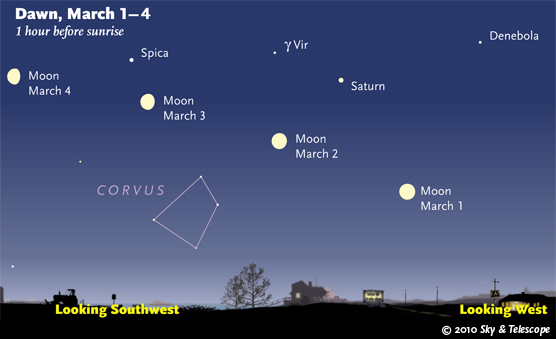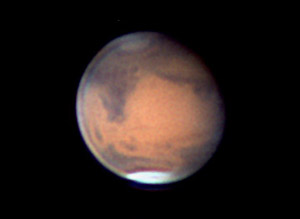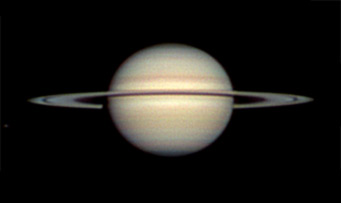Some daily events in the changing sky for February 26 – March 6.
Friday, February 26
Saturday, February 27
Sunday, February 28
Monday, March 1

Early risers can follow the waning Moon passing under Saturn and Spica in early dawn.
Sky & Telescope diagram
Tuesday, March 2
Wednesday, March 3
Thursday, March 4
Friday, March 5
Saturday, March 6
Want to become a better amateur astronomer? Learn your way around the constellations. They're the key to locating everything fainter and deeper to hunt with binoculars or a telescope. For an easy-to-use constellation guide covering the whole evening sky, use the big monthly map in the center of each issue of Sky & Telescope, the essential magazine of astronomy. Or download our free Getting Started in Astronomy booklet (which only has bimonthly maps).

The Pocket Sky Atlas plots 30,796 stars to magnitude 7.6 — which may sound like a lot, but that's less than one star in an entire telescopic field of view, on average. By comparison, Sky Atlas 2000.0 plots 81,312 stars to magnitude 8.5, typically one or two stars per telescopic field. Both atlases include many hundreds of deep-sky targets — galaxies, star clusters, and nebulae — to hunt among the stars.
Sky & Telescope
Once you get a telescope, to put it to good use you'll need a detailed, large-scale sky atlas (set of charts; the standards are Sky Atlas 2000.0 or the smaller Pocket Sky Atlas) and good deep-sky guidebooks (such as Sky Atlas 2000.0 Companion by Strong and Sinnott, the more detailed and descriptive Night Sky Observer's Guide by Kepple and Sanner, or the classic Burnham's Celestial Handbook). Read how to use them effectively.
Can a computerized telescope take their place? I don't think so — not for beginners, anyway (and especially not on mounts that are less than top-quality mechanically). As Terence Dickinson and Alan Dyer say in their Backyard Astronomer's Guide, "A full appreciation of the universe cannot come without developing the skills to find things in the sky and understanding how the sky works. This knowledge comes only by spending time under the stars with star maps in hand and a curious mind." Without these, "the sky never becomes a friendly place."
More beginners' tips: "How to Start Right in Astronomy".
This Week's Planet Roundup

Mars is gibbous now; it's more than a month past opposition. The north polar cap (bottom) remains big and bright despite the advance of spring in the Martian northern hemisphere. At center-left is dark Syrtis Major; at upper right are dark Sinus Sabaeus and Sinus Meridiani. At top, the Hellas region is slightly bright.
Christopher Go in the Philippines took this image at 14:00 UT March 3rd, when the central meridian longitude was 321°. Stacked-video imagery like this can show detail on a planet much more clearly than the eye can see through the same telescope.
Christopher Go
Mercury is hidden behind the glare of the Sun.
Venus (magnitude –3.9) is slowly emerging into view very low in the sunset. Look for it just above the western horizon about 30 minutes after sundown. Binoculars help. Venus will gradually creep up into better twilight visibility for the next threre months.
Mars, still bright at magnitude –0.6, shines high in the east at dusk and highest in the south around 9 or 10 p.m. It's located in Cancer, below Pollux and Castor after dusk.
In a telescope Mars is shrinking: from 12.4 to 11.6 arcseconds wide this week. Its north polar cap remains the most visible marking. Identify other surface features you detect in your scope using the Mars map and observing guide in the December issue of Sky & Telescope, page 57.
Jupiter is out of sight in conjunction with the Sun.

"Here's my first image of Saturn this season," writes Christopher Go from the Philippines. "The South Equatorial Belt [above center] is very dark. The color of both hemispheres are almost the same but the north is slightly darker. Lots of belt details on both hemispheres. The North Polar Region is dark." South is up; we'll be looking at the north face of the rings for the next 15 years.
Go images the planets with a Celestron 11 scope on an AP900GTO mount using a DMK 21F04 camera. Stacked-video images like this show more detail than the eye can see even through the same telescope.
Saturn (magnitude +0.6, in western Virgo) rises in the east around the end of twilight and stands highest in the south around 1 a.m. In a telescope, Saturn's rings are tilted only 4° from edge-on to us, as seen at right. They'll narrow further (to 1.7°) in the coming months.
Uranus and Neptune are behind the glare of the Sun.
Pluto is up in the southeast before dawn.
All descriptions that relate to your horizon or zenith — including the words up, down, right, and left — are written for the world's mid-northern latitudes. Descriptions that also depend on longitude (mainly Moon positions) are for North America. Eastern Standard Time (EST) equals Universal Time (also known as UT, UTC, or GMT) minus 5 hours.
To be sure to get the current Sky at a Glance, bookmark this URL:
http://SkyandTelescope.com/observing/ataglance?1=1
If pictures fail to load, refresh the page. If they still fail to load, change the 1 at the end of the URL to any other character and try again.
 0
0
Comments
You must be logged in to post a comment.